Seasons – May 2023
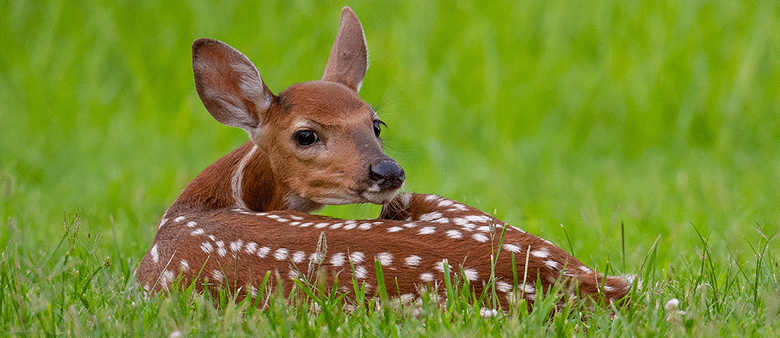
From the Plateau Land & Wildlife Management Team
Named after the Greek goddess Maia, the month of May brings warmer temps, blooming flowers, and the fresh beginnings of summer. Before the final touchstones of Spring fade away, there’s no better way to make the most of this month than getting outside and enjoying your property.
In this issue of Seasons, you’ll find guides by Plateau’s team of biologists and Wildlife Management staff to help you make the most out of the remaining spring season. We’ll cover tips to ensure you’re on track with Spring Management Activities, examine the benefits of Riparian Zones, discuss landowner benefits for protecting and supporting the endangered Houston Toad, cover Tips For Navigating Property Tax Protests, share news for Texas landowners, and more.
We hope you enjoy the read and everything this edition has to offer, and if there’s any way Plateau can help you protect, enhance or better enjoy your land during this beautiful season, just give us a call. We’ll be here when you need us.
Until next Seasons,
The Plateau Team
Table of Contents
A River Runs Through It: The Importance of Riparian Zones
Protecting and Restoring the Houston Toad
Wildlife Management Activity Reminder: Spring Checklist
“I Found a Fawn” – Tips for Interactions with Newborn Wildlife
Braun & Gresham: Tips for Protesting Your Property Taxes
News for Texas Landowners
A River Runs Through It: The Importance of Riparian Zones
By Shane Kiefer, Director Of Ecological Services, Certified Wildlife Biologist, Senior Property Tax Consultant
What is a Riparian Zone?
Rip arian zones occur around lakes, reservoirs, and wetlands, but they are more commonly associated with rivers and streams. There are 15 major rivers that flow through Texas and nearly 200,000 miles of streams and rivers in the state. Not everyone has riverfront property, but many people have some sort of watercourse flowing through their land. The supply of water and nutrients in these areas supports vegetation that does not occur in the surrounding uplands. The diverse structure and composition of these areas provide long, connected corridors of habitat for wildlife. These areas are known as riparian zones or riparian systems.
arian zones occur around lakes, reservoirs, and wetlands, but they are more commonly associated with rivers and streams. There are 15 major rivers that flow through Texas and nearly 200,000 miles of streams and rivers in the state. Not everyone has riverfront property, but many people have some sort of watercourse flowing through their land. The supply of water and nutrients in these areas supports vegetation that does not occur in the surrounding uplands. The diverse structure and composition of these areas provide long, connected corridors of habitat for wildlife. These areas are known as riparian zones or riparian systems.
Wetlands are characterized by soils that are typically saturated by water and poorly drained, but riparian zones only experience periodic flooding in well-drained soils with a water table that is much closer to the surface than in upland habitats. Riparian vegetation relies on occasional access to free water in the water table to survive. Bald cypress, sycamore, pecan, and black willow are just a few of the many plants that require at least temporary access to the water table or elevated soil moisture to thrive.
People, livestock, and wildlife all rely on riparian zones. People utilize them heavily for recreation, as a quick drive to any river during the summer (except perhaps Summer 2020) will tell you. Livestock and people use them for similar reasons – water, food, and cooler temperatures. Many species of wildlife rely on riparian zones to survive. They produce enormous quantities of food and often provide access to the only water available for miles. As with most water-associated areas, the extremes of the surrounding uplands are moderated in riparian zones. While they offer cool shade in the summer, the dense vegetation also offers thermal insulation in the winter.
In addition to providing wildlife habitat, properly vegetated riparian zones also absorb water and energy from floods, reducing downstream flooding and erosion and the damage it causes while increasing infiltration for groundwater recharge. Shading helps keep water temperatures cool, providing higher levels of dissolved oxygen for aquatic organisms. Tree roots and grasses growing along stream banks trap sediment from upstream erosion, helping to clean the water before it moves on. The underground biomass in these systems can exceed what you see growing aboveground, and all that underground material acts like a sponge to absorb, hold, and slowly release water. Since it all flows downhill, proper management of your riparian zones benefits not only you but everyone downstream as well.
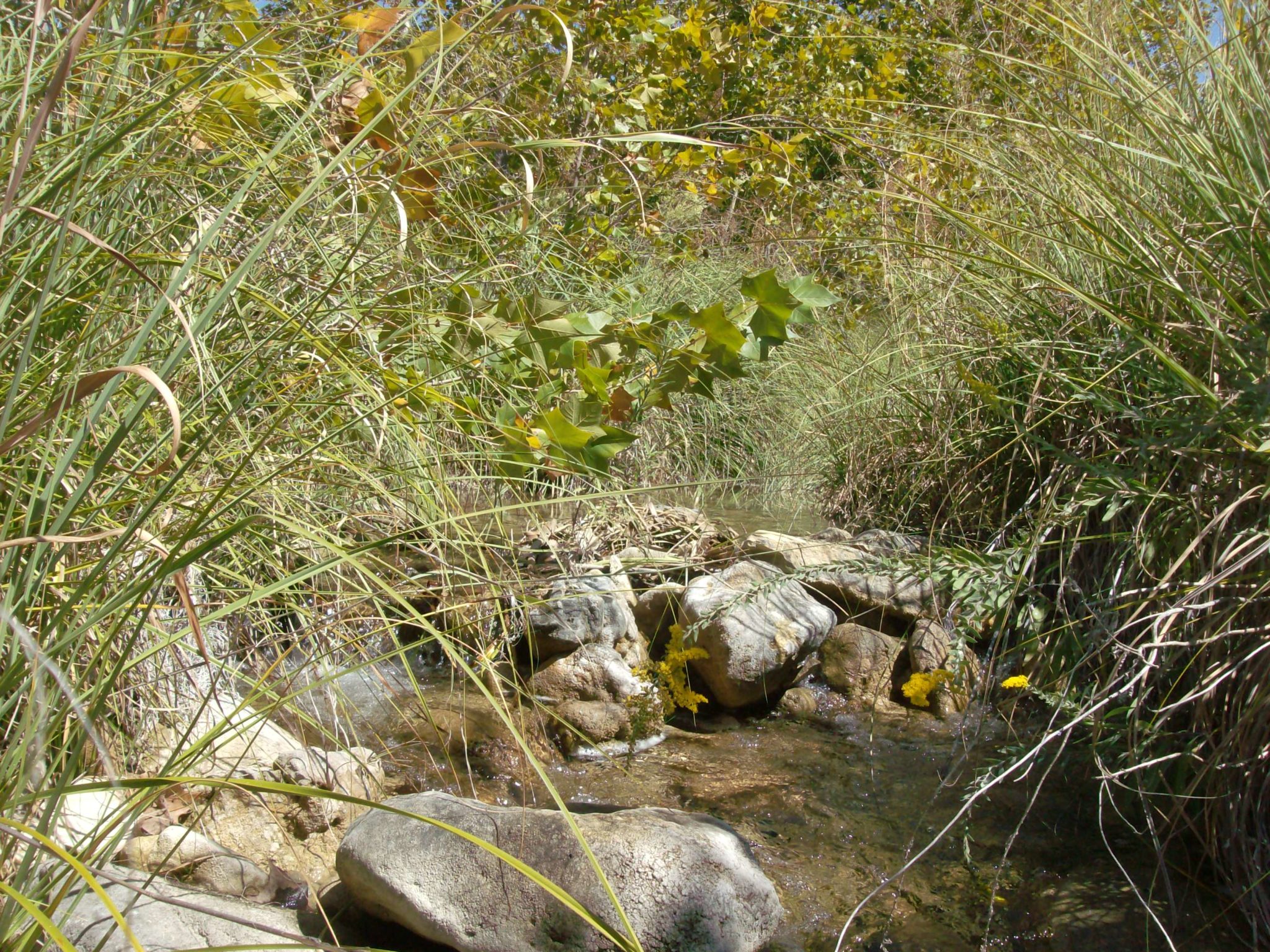 How do Riparian Zones impact Wildlife
How do Riparian Zones impact Wildlife
Perhaps the most important aspect of riparian zones for many small landowners is their role as travel corridors for wildlife of all kinds. Small acreage landowners can provide a variety of benefits for wildlife on their property, but these patches of quality habitat are often isolated from each other by different land uses. Heavily wooded streams provide protection for deer, turkey, bobcats, songbirds, and other mobile animals as they move from patch to patch, like a highway system for wildlife. Even if the surrounding habitat is in poor condition, wildlife can use riparian corridors to find quality habitat on nearby properties. Those of you lucky enough to have riparian habitat likely have many more species of wildlife at any given time than those with only upland habitat.
Due to the fact that riparian zones often occupy very small areas in relation to their benefits, they are more susceptible to degradation and poor management. Livestock can be particularly hard on stream banks and riparian vegetation, just as people are along urban rivers. Vehicles can damage riparian areas as well, but this can be mitigated by installing alternate routes or low water crossings. The need to provide access to water and protect your streams and rivers can be balanced by restricting livestock and recreational access to targeted areas, leaving most of the bank in a more natural state. While a long, clean bank of shortly mowed grass with a few trees makes it easy to see and access your stream, it is an entirely unnatural condition that creates a poorly functioning riparian area.
Riparian systems are self-managing in many ways if we can avoid putting up obstacles to natural processes. Sometimes well-meaning efforts such as excessive vegetation removal, dams, removal of large wood, and typical engineered “solutions” often create larger issues by interfering with natural processes. Knowing how to identify functional riparian systems and things that hinder function are the best tools in your management toolbox for these special areas. Sometimes the best management is to stop “managing” so you can get the most out of these habitats that are small in size but big in benefits.
For a wealth of information on riparian areas and their management please visit www.remarkableriparian.org.
Have questions about Riparian Zones? Please contact us at [email protected] or (512) 894-3479.
Protecting and Restoring the Houston Toad
By Nick Fisher, Regional Manager, Plateau Land & Wildlife Management
Concealed in the historic forests of central Texas’ loblolly pines and post oak savannah region, a high-pitched trill of a small toad can be heard calling from ephemeral pools as the months begin to warm. The Houston Toad (Anaxyrus houstonensis) once found throughout the east central region of Texas, is now almost exclusively detected in isolated populations in Bastrop County.
A victim of Texas’ rapid urbanization, these toads hang on the brink of extinction due to habitat loss, introduction of non-native species, and the suppression of natural fire regimes. Known as a habitat-specialist, only nine Texas counties from Bastrop to Leon still contain some of the specialized habitat that the Houston toad once thrived in. In 1970, the Houston toad became one of the first amphibians to be placed on the USFWS Endangered Species list. Today, official estimates are that just 3,000–4,000 adult Houston toads are left in the world.
Non-profits like Ft. Worth Zoo, Dallas Zoo, and the Houston Zoo have aligned in conservation efforts and have played a huge part in “head-starting,” or breeding the toads and introducing them to the wild with a “head start on life”. The “head start” program has been essential to the toad’s survival after the catastrophic fires in the Bastrop area in recent decades, at least for now while populations recover.
Even if all zoos and like-minded non-profits in Texas worked towards this program for the toads, several factors make the road to recovery challenging. The toad’s fate is in the hands of the private landowners in a state that’s 95% privately owned, where urbanization seems to be never-ending. To conserve the Houston Toad, protecting the habitat is more important now than ever.
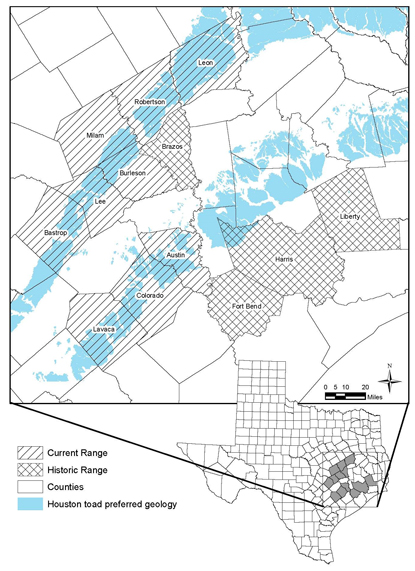
Houston Toad Habitat Distribution
Conservation Programs and Incentives for Landowners
Beyond protecting such a unique and extraordinary piece of Texas wildlife, why would a landowner want to volunteer for the “red tape” involved with protecting a federally endangered species? Programs like Texas Parks and Wildlife’s Safe Harbor Agreement and the Wildlife Management Tax Valuation offer incentives to private landowners who wish to manage for the toads specifically, or for the habitat that could benefit both toads and other native Texas wildlife.
Some landowners have expressed a valid concern that improving the habitat of a federally endangered species on private land may result in an increased population of the species, and therefore increase the odds of accidentally harming or killing one of the individuals. Safe Harbor Agreements offer landowners legal protection and an assurance that the landowner will NOT be held liable for incidental take (harming individual toads) while conducting habitat improvements on their property. In return, the landowner agrees to provide habitat enhancements for the toads that will assist with the recovery of the species. Landowners will receive free technical guidance from Texas Parks and Wildlife and can even apply for cost-share assistance for habitat improvement practices.
Many of the habitat improvements that are recommended for benefiting the Houston toad align with the activities that can count for compliance with the Wildlife Management Tax Valuation. Invasive red fire ant control, low intensity grazing, fencing off wetland areas from cattle, and even periodic burning can all improve the habitat for Houston toads while satisfying the requirements for maintaining low property taxes for properties that are under the 1-D-1 Open Space tax valuation for Wildlife Management.
How to get started
If you are a landowner within the Post Oak Savannah region, and you are interested in learning more about managing your property to help Post Oak Savanna wildlife, Texas Parks and Wildlife Department is hosting “Wildlife & Woodlands – Post Oak Savannah Landowner Workshops” in Robertson, Leon, and Milam/Burleson counties in July and August. This is a unique opportunity to hear from TPWD’s Conservation Initiatives Specialist, Elizabeth Bates and our State Herpetologist, Paul Krump as they discuss management techniques and offer guidance for private landowners interested in conservation efforts and habitat enhancements. These workshops are not only for those with an interest in Houston toads. Anyone interested in learning about habitat management in the Post Oak Savanna is sure to benefit.
Have questions about Wildlife Management for Houston Toads? Please contact Nick Fisher at [email protected] or (512) 894-3479.
Activity Reminder: Spring Wildlife Management Checklist
By Kameron Bain, Landowner Account Manager
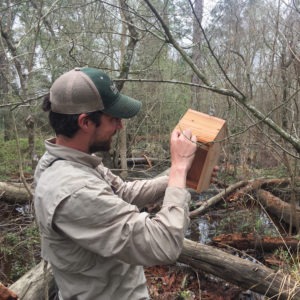 Don’t let summer sneak up on you before you complete your Spring wildlife management activities.
Don’t let summer sneak up on you before you complete your Spring wildlife management activities.
From bluebonnets blooming to birds zipping around, the signs of spring are all around us, but they won’t last long. This is an important season for wildlife management plan landowners with several key activities to accomplish before the the end of the season. With spring halfway over, we want to make sure you are on track to finish your spring qualifying wildlife management activities and that they are well documented. Here’s a quick checklist to review to ensure you’ve completed the activities that align with your management goals:
- Predator Control
- Imported Red Fire Ant Control
- Brown-headed cowbirds during breeding bird season
- Erosion Control
- Supplemental Water
- Spring Breeding Bird Surveys
- Re-Seeding Native Grasses
There are plenty of timely activities to choose from, and of course, Plateau is always here to help when you need us.
To schedule a service for your property, contact us at [email protected] or (512) 894-3479.
I found a baby deer alone on my property – do they need help?
James A. Hall, Staff Biologist of Plateau Land and Wildlife Management
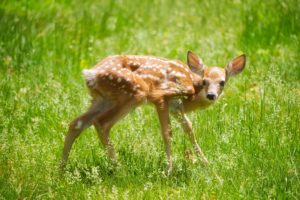 Spring is underway in Texas, heralded by warmer temperatures, birdsong, and blooming plant life. For White-tailed Deer (Odocoileus virginianus), this is the beginning of the fawning season.
Spring is underway in Texas, heralded by warmer temperatures, birdsong, and blooming plant life. For White-tailed Deer (Odocoileus virginianus), this is the beginning of the fawning season.
It is common to find a fawn bedded in tall vegetation, lying still, and seemingly abandoned with mother doe nowhere in sight. While the young animal appears to be alone and requiring our assistance, our intervention can actually become detrimental to its survival.
Fawns are not yet strong enough to follow their mother around all day. Periods of motionless isolation is a perfectly natural form of avoiding detection from predators, while the doe forages or rests elsewhere. More than likely, as we attempt to care for the “orphaned” fawn, the doe is nearby and attentive to its offspring. Therefore, handling a bedded fawn is often unnecessary, and will cause undue stress to the animal.
If the fawn appears emaciated or injured, then it is acceptable to provide aid by contacting a wildlife rehabilitator. Otherwise, do not handle or disturb the animal, other than snapping a picture and taking a brief moment to admire nature at its work.
Back to TopBack to TopTips for Navigating Property Tax Protests
Cassie Gresham, Braun & Gresham Attorney and Counselor
Cassie Gresham, Braun & Gresham attorney and counselor, reviews best practices for protesting your property tax valuation.
Braun & Gresham Attorney and Counselor, Cassie Gresham, provides tips for navigating property tax protests. Cassie covers your deadlines to protest, considerations for working through the Appraisal Review Board process, common mistakes and pitfalls, and more. This webinar will benefit any landowner and provide insight on how to properly protest your property tax valuation.
For more information about Gresham and Braun & Gresham law firm, visit: https://braungresham.com/meet-the-team/cassie-gresham/ .
News for Texas Landowners
Texas House Passes Legislation To Create Historic Texas Land And Water Conservation Fund
Article by KSST Radio
 With an overwhelming vote of 131-13, the Texas House passed HB 3165 to create the Texas Land and Water Conservation Fund. The vote follows a 139-2 vote for HJR 138, which would put the fund on the November ballot as a constitutional amendment, allowing Texas voters to declare their support for conserving land and water for future generations. The legislation will now proceed to the Senate for a vote. “The Texas House acted boldly to preserve what we love about Texas,” said Rep. Justin Holland who authored the bill. “This fund supports land and water conservation efforts for both public recreation and natural resource conservation that will allow Texas to thrive for generations to come. Because 95% of Texas is privately owned, it is vital we encourage private conservation along with the expansion of public parks, and this legislation achieves that goal.”
With an overwhelming vote of 131-13, the Texas House passed HB 3165 to create the Texas Land and Water Conservation Fund. The vote follows a 139-2 vote for HJR 138, which would put the fund on the November ballot as a constitutional amendment, allowing Texas voters to declare their support for conserving land and water for future generations. The legislation will now proceed to the Senate for a vote. “The Texas House acted boldly to preserve what we love about Texas,” said Rep. Justin Holland who authored the bill. “This fund supports land and water conservation efforts for both public recreation and natural resource conservation that will allow Texas to thrive for generations to come. Because 95% of Texas is privately owned, it is vital we encourage private conservation along with the expansion of public parks, and this legislation achieves that goal.”
Enrollment open for Managed Lands Deer Program
Article by TPWD

AUSTIN — Enrollment in the Texas Parks and Wildlife Department’s Managed Lands Deer Program (MLDP) is now open for the 2023–24 hunting season. Open enrollment for the MLDP Conservation Option runs April 2 through June 15; the Harvest Option opens May 1 and ends Sept. 1.
MLDP is a program intended to foster and support sound management and stewardship of native wildlife and habitats on private lands in Texas. Deer harvest is an important aspect of habitat management and conservation. Landowners enrolled in either the MLDP Harvest Option or Conservation Option can take advantage of extended seasons and property-specific customized harvest opportunities.
When Pumas are Gone, Nothing Can Quite Take Their Place
Article by David Frey for The Wildlife Society
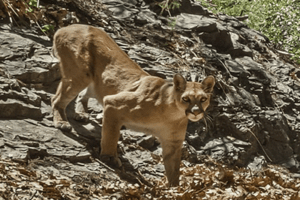
Coyotes thrive at Fort Hood, but they don’t fill the role of apex predator
From their perch at the top of the food web, apex predators can shape the ecosystem around them. To understand just how important they can be, it may help to look at places where these keystone species have vanished.
That was the idea behind Alex Avrin’s research on the role pumas play as apex predators. As a master’s student at the University of Illinois, Avrin was interested in how their absence affected the ecosystem around the military installation of Fort Hood, Texas.
Fort Worth Zoo Releases Endangered Houston Toads
Press Release for Fort Worth Zoo
 Over the last eight weeks, the Fort Worth Zoo in Fort Worth, Texas, released 718,553 endangered Houston toad tadpoles and eggs into their native range on a designated, protected release site in Bastrop County.
Over the last eight weeks, the Fort Worth Zoo in Fort Worth, Texas, released 718,553 endangered Houston toad tadpoles and eggs into their native range on a designated, protected release site in Bastrop County.
The Zoo has partnered with Texas State University in San Marcos, Texas, and the Houston Zoo in Houston, Texas, for Houston toad recovery since 2010. The Zoo is one of only four facilities that breed this species under managed care. This year’s toads have produced more eggs and tadpoles than all the previous years combined since the program began in 2010 (2010-2022 total tadpoles and eggs: 665,813).
The Ringtail Is Texas’s Nighttime Ninja
Article by Texas Texas Monthly
 The elusive creature weighs only a pound or two and looks like a mix of a domestic cat (although the two aren’t related), a fox, a ferret, and a raccoon. Padding silently in the night on tiny pink paws, with wide eyes, a pointed snout, and rounded ears, it’s cute in a strange and wild way. The signature ringed tail sets it apart, coasting fluffily behind its furry body in a long cascade of black and white stripes. This is the ringtail, the cutest little mammal you might never have heard of (or seen).
The elusive creature weighs only a pound or two and looks like a mix of a domestic cat (although the two aren’t related), a fox, a ferret, and a raccoon. Padding silently in the night on tiny pink paws, with wide eyes, a pointed snout, and rounded ears, it’s cute in a strange and wild way. The signature ringed tail sets it apart, coasting fluffily behind its furry body in a long cascade of black and white stripes. This is the ringtail, the cutest little mammal you might never have heard of (or seen).
Ringtails are common in Central and West Texas, in part because they love rocky, semiarid conditions. Though the species is less prevalent in East Texas, it does enjoy woody regions, especially those near sources of water. Ringtails are also excellent hunters. They will eat almost anything, but they have a particular fondness for figs.
And You Thought Feral Hogs Were Bad. Fire Ants Have Unleashed Chaos In Texas For Decades.
Article by Texas Texas Monthly
 When Solenopsis invicta, a.k.a. the red imported fire ant, was first identified in East Texas, in the seventies, stakes were high. Since hitching a ride from Brazil to Alabama in a ship’s ballast a few decades earlier, the insects had resisted all efforts to slow their long march west. Experts predicted that they would wreak untold havoc on Texas’s ecosystem.
When Solenopsis invicta, a.k.a. the red imported fire ant, was first identified in East Texas, in the seventies, stakes were high. Since hitching a ride from Brazil to Alabama in a ship’s ballast a few decades earlier, the insects had resisted all efforts to slow their long march west. Experts predicted that they would wreak untold havoc on Texas’s ecosystem.
In response, counties set up quarantine areas that quickly doubled, then tripled, in size. The Texas Department of Agriculture doused more than half a million acres with a chemical called MV-678 that was supposed to render the next generation of fire ants sterile and lazy. (It did not.) Landowners drenched fire ants in diesel oil, convinced that this was an effective method for doing away with them. (It wasn’t.) The August 1988 cover of Texas Monthly declared the fire ant “Public Enemy #1.”
The State of Texas Water
Content by Texas Water Foundation, featured in Texas Monthly
 There’s no denying that water shapes Texas. It defines our state’s iconic shape and sustains our thriving economy. From the settlement of our earliest communities, to the growth of our modern cities and industries, water is the lifeblood of our state. But it is also our Achilles heel.
There’s no denying that water shapes Texas. It defines our state’s iconic shape and sustains our thriving economy. From the settlement of our earliest communities, to the growth of our modern cities and industries, water is the lifeblood of our state. But it is also our Achilles heel.
Droughts threatening crops and livestock is a fact of life in the Lone Star State. A drive through West Texas will show you a century’s worth of ghost towns and farms that have faded away as their wells, springs, and rivers were depleted, polluted, or diverted to another use. Our history is a tale of prolonged drought, punctuated by disastrous floods.
Property north of San Antonio set to become a new Texas state park
Article by MySa
 A new report says that a massive piece of Texas Hill Country property just outside of San Antonio is one of three pieces of land set to become a new state park after years of legislative funding hold ups. The 3,800-acre property in the Pipe Creek area that was bought buy a family years ago to protect it from commercial builders is now being developed as a new piece of land for the Texas Parks and Wildlife Department, the Dallas Morning news reports. The property, known as the Albert & Bessie Kronkosky State Natural Area, is set to open in two years under TPWD and is just a little over an hour northwest of San Antonio. It’s named after the Kronkosky family, which started buying up the parcels of land in 1946. The couple left the land to Texas in their will, which the state accepted in 2011.
A new report says that a massive piece of Texas Hill Country property just outside of San Antonio is one of three pieces of land set to become a new state park after years of legislative funding hold ups. The 3,800-acre property in the Pipe Creek area that was bought buy a family years ago to protect it from commercial builders is now being developed as a new piece of land for the Texas Parks and Wildlife Department, the Dallas Morning news reports. The property, known as the Albert & Bessie Kronkosky State Natural Area, is set to open in two years under TPWD and is just a little over an hour northwest of San Antonio. It’s named after the Kronkosky family, which started buying up the parcels of land in 1946. The couple left the land to Texas in their will, which the state accepted in 2011.
Texas House passes $12 billion property tax relief package, setting up fight over appraisal cap with Senate
Article by Texas Tribune
 A $12 billion proposal aimed at giving property tax relief to Texas homeowners and businesses cleared a major hurdle Friday in the Texas House, setting up a showdown with the Senate over their warring tax-cut packages.
A $12 billion proposal aimed at giving property tax relief to Texas homeowners and businesses cleared a major hurdle Friday in the Texas House, setting up a showdown with the Senate over their warring tax-cut packages.
House Bill 2 — backed by House Speaker Dade Phelan and carried by state Rep. Morgan Meyer, both Republicans — passed the full House by a 139-5 vote after gaining initial approval from the chamber the previous day. The bill proposes pumping $12 billion into Texas school districts so that they, in turn, can lower their property taxes on home and business owners. For the owner of a $350,000 home, the package would result in more than $1,000 in savings over two years, according to Phelan’s office.
How to protest your 2023 property appraisal in Central Texas
Article by KXAN
 Did you already get your 2023 property appraisal? Disagree with it? Texas property owners have until May 15 to file a protest with their county’s appraisal district. This year, Travis County’s appraisal roll increased 13%. In Williamson County, appraised values decreased 12% from 2022. In Hays County, appraisal values went up 24% this year.
Did you already get your 2023 property appraisal? Disagree with it? Texas property owners have until May 15 to file a protest with their county’s appraisal district. This year, Travis County’s appraisal roll increased 13%. In Williamson County, appraised values decreased 12% from 2022. In Hays County, appraisal values went up 24% this year.
If a property owner disagrees with an appraisal value, they can submit a protest to their county’s appraisal district. Then, the county’s appraisal review board hears the taxpayer’s protest and resolves the dispute between the property owner and the appraisal district. The board is a citizen group that determines the outcome of a protest.
TPWD provides anglers with best catch/release practices for alligator gar
Article by News Release by TPWD in Waxahatchie Sun
 Alligator gar hold a special place in Texans’ hearts as the largest and longest-living freshwater species in the state. The Texas Parks and Wildlife Department (TPWD) works to ensure healthy populations remain in Texas for future generations to enjoy. As waters warm and alligator gar fishing heats up this summer, TPWD is working with anglers, who play a key role in conservation efforts through proper catch-and-release practices. “Catch-and-release fishing for alligator gar has become quite popular and data from a current evaluation in progress indicates high survival rates for released fish,” said Dan Daugherty, TPWD Inland Fisheries senior scientist. “We’ve even recorded some fish being caught and released three or four times over multiple years.”
Alligator gar hold a special place in Texans’ hearts as the largest and longest-living freshwater species in the state. The Texas Parks and Wildlife Department (TPWD) works to ensure healthy populations remain in Texas for future generations to enjoy. As waters warm and alligator gar fishing heats up this summer, TPWD is working with anglers, who play a key role in conservation efforts through proper catch-and-release practices. “Catch-and-release fishing for alligator gar has become quite popular and data from a current evaluation in progress indicates high survival rates for released fish,” said Dan Daugherty, TPWD Inland Fisheries senior scientist. “We’ve even recorded some fish being caught and released three or four times over multiple years.”






Sorry, the comment form is closed at this time.